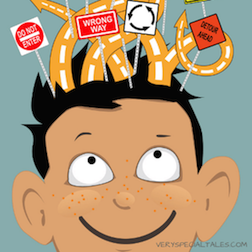Imagine standing in line to order a coffee. You could jump to the front of the line, skipping over everyone in front of you, and bark your order. OR you could wait in line for your turn and then place your order.
Most adults have the self-control to pause and do what’s right in a given situation. They wait in line for their coffee because that is what is appropriate and is proper etiquette. Typically, most adults think before they act and do what’s right in order to gain the best outcome, whether it’s a social situation, at work, or in their community.
What about kids? What does self-control mean for them and how do we help foster this skill?
What is Self Control?
Self-control is part of a group of skills (called executive functions) that allows kids to manage their thoughts, emotions, and actions in order to get things done successfully. Self control can be broken down into three categories: impulse control, emotional control, and movement control. Having self-control helps kids in all areas of their life, but is particularly important when it comes to socializing and academic success. Being in control of one’s actions helps kids to interact, connect, set goals and achieve them.
Self-control develops in children over time, and well through the teenage years. The older kids get, the better they’re able to:
Academics: Wait to be called on in class instead of blurting out the answer. They can better reflect on what the teacher said.
Socially: Handle gentle teasing without bursting into tears and can come up with better ways of reacting.
At home: Not interrupt conversations (as much!), even when they really want to say something. They can wait until the person speaking has finished.
Tips and Tricks:
Create a secret signal. Kids who struggle with self-control need reminders to keep themselves on track both in the classroom and beyond. However, reminding a child verbally in front of his/her classmates or at the playground may hurt their fragile self-esteem. Together, decide on a gesture or signal that will convey to your child that the behavior happening at the current moment needs to change.
Stop, think, act. This is a great way to teach your child how to pause, stop and think before speaking or acting. When your child reacts impulsively to a situation, ask them (once the situation has diffused):
“Did that make things better or worse?”
“What emotion were you feeling when that happened?”
“What did it feel like inside of your body?”
With practice, they will be able to better recognize their physical response, asking themselves the above questions before speaking or acting. You can sometimes preempt this as well — “Remember to think about what would make it better or worse!”
Kids do things before they think all of the time! They are not always aware that what they are doing is not okay. In time and with certain tools, they’ll get the hang of it.
Every student has a different learning style. For an individualized plan customized to your child's needs, please contact Dana Aussenberg at danaaussenberg.com or email dana@danaaussenberg.com.


